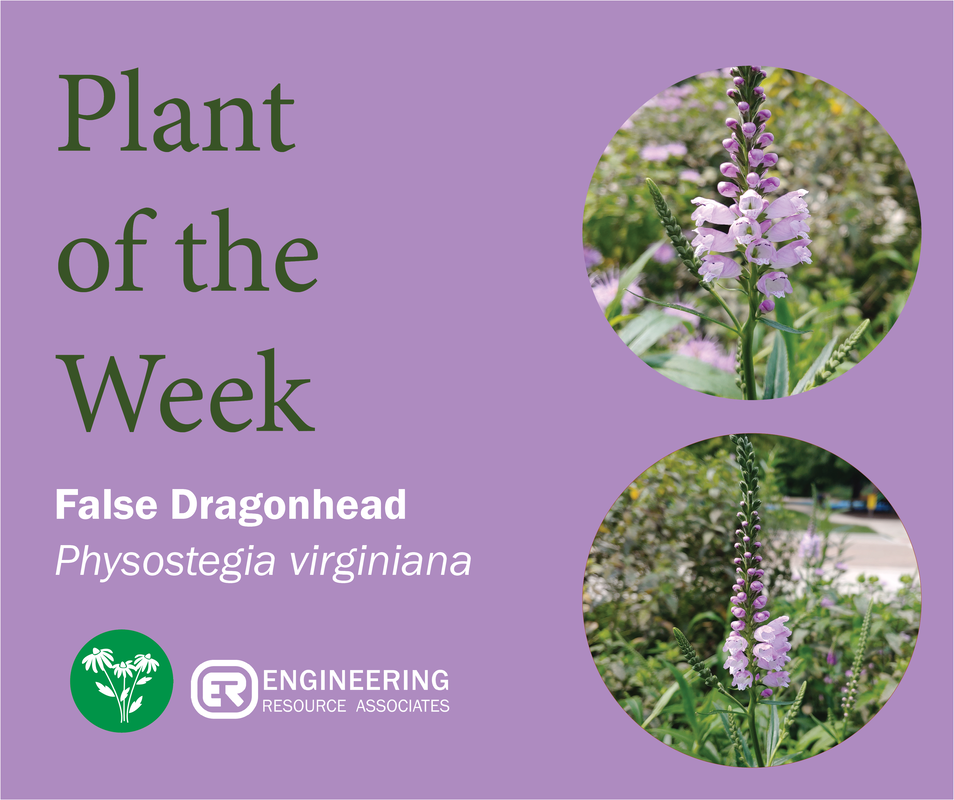This week’s plant is Physostegia virginiana, commonly known as false dragonhead or obedient plant.
This attractive native member of the mint family is right at home in landscaping beds where they get a lot of sun and moisture. It is also particularly well suited to rain gardens. The common name ‘obedient plant’ comes from an unusual trait that leaves the flower in whichever direction you point it towards. Alternatively, this plant slightly resembles another landscape plant, the dragonhead or snapdragon, leading to the other common name, ‘false dragonhead’. If you are planting an obedient plant in a landscape setting, be sure to give it lots of space as it tends to spread quickly when planted in a favorable site.
Aside from the playful flowers, attractive growth habits, and usefulness in the garden, one fascinating feature about this plant is the reproductive structures located inside the flower itself. When people visualize a flower, they tend to picture the pollen-producing organs in the center where a bee may land to collect food for the hive, typical of the compound flowers of the aster and sunflower family. The Obedient Plant, however, has other ideas. The male reproductive organs (anthers) and the female organ (stigma) are located on the top of the flower directly above a central lobed petal that acts as a landing pad for bees, moths, or other pollinators seeking pollen or nectar. Instead of being rewarded with pollen at the rear of the flower as is typical of many flowering plants, pollinators are rewarded with a sort of 'pat on the back' as the anthers dip down and deposit pollen on the back of its visitor while they crawl to the back of the tube-shaped flower seeking nectar. This ensures pollen is not gathered as a resource and will be accurately deposited on the stigma of the next obedient plant the pollinator visits.
Next time you visit a municipal park or see a rain garden, keep an eye out for these interesting plants and see if you can spot pollinators crawling in and out of the little tubular flowers!
This attractive native member of the mint family is right at home in landscaping beds where they get a lot of sun and moisture. It is also particularly well suited to rain gardens. The common name ‘obedient plant’ comes from an unusual trait that leaves the flower in whichever direction you point it towards. Alternatively, this plant slightly resembles another landscape plant, the dragonhead or snapdragon, leading to the other common name, ‘false dragonhead’. If you are planting an obedient plant in a landscape setting, be sure to give it lots of space as it tends to spread quickly when planted in a favorable site.
Aside from the playful flowers, attractive growth habits, and usefulness in the garden, one fascinating feature about this plant is the reproductive structures located inside the flower itself. When people visualize a flower, they tend to picture the pollen-producing organs in the center where a bee may land to collect food for the hive, typical of the compound flowers of the aster and sunflower family. The Obedient Plant, however, has other ideas. The male reproductive organs (anthers) and the female organ (stigma) are located on the top of the flower directly above a central lobed petal that acts as a landing pad for bees, moths, or other pollinators seeking pollen or nectar. Instead of being rewarded with pollen at the rear of the flower as is typical of many flowering plants, pollinators are rewarded with a sort of 'pat on the back' as the anthers dip down and deposit pollen on the back of its visitor while they crawl to the back of the tube-shaped flower seeking nectar. This ensures pollen is not gathered as a resource and will be accurately deposited on the stigma of the next obedient plant the pollinator visits.
Next time you visit a municipal park or see a rain garden, keep an eye out for these interesting plants and see if you can spot pollinators crawling in and out of the little tubular flowers!

